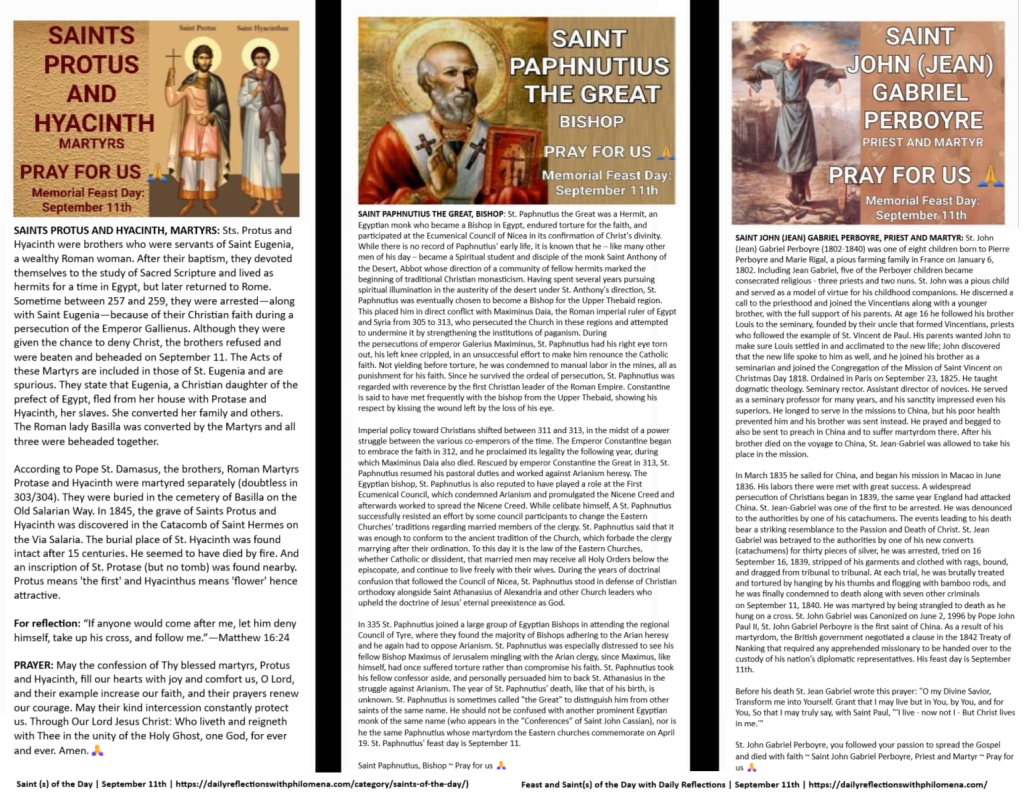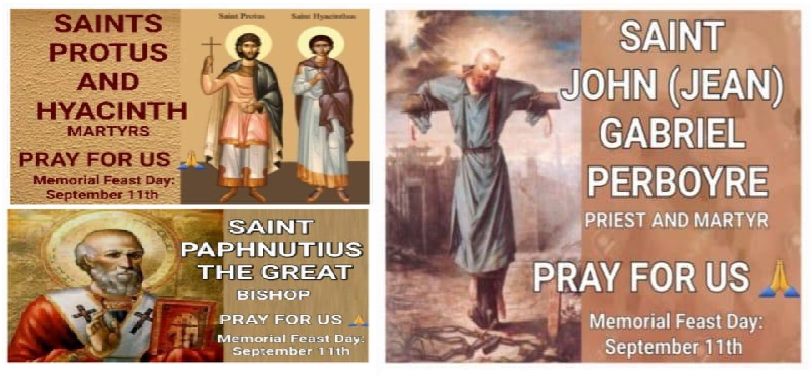
SAINT PROTUS AND HYACINTH, MARTYRS; SAINT PAPHNUTIUS THE GREAT, BISHOP AND SAINT JOHN (JEAN) GABRIEL PERBOYRE, PRIEST AND MARTYR ~ FEAST DAY: SEPTEMBER 11TH: Today, we celebrate the Memorial of Saints Protus and Hyacinth, Martyrs and Saint Paphnutius the Great, Bishop and Saint John (Jean) Gabriel Perboyre, Priest and Martyr. Through the intercession of our Blessed Mother Mary and the Saints on this feast day, we humbly pray for the sick and dying, especially those who are mentally and physically ill and those suffering from cancers and other terminal diseases. We pray for the souls in Purgatory and the repose of the souls of the faithful departed. We pray for the poor and needy and for peace, love, and unity in our marriages, our families, and our world. And we continue to pray for our Holy Father, the Bishops, the Clergy, for vocations to the priesthood and religious life, for the Church, for persecuted christians, for the conversion of sinners, and Christians all over the world…. Amen🙏
SAINTS PROTUS AND HYACINTH, MARTYRS: Sts. Protus and Hyacinth were brothers who were servants of Saint Eugenia, a wealthy Roman woman. After their baptism, they devoted themselves to the study of Sacred Scripture and lived as hermits for a time in Egypt, but later returned to Rome. Sometime between 257 and 259, they were arrested—along with Saint Eugenia—because of their Christian faith during a persecution of the Emperor Gallienus. Although they were given the chance to deny Christ, the brothers refused and were beaten and beheaded on September 11. The Acts of these Martyrs are included in those of St. Eugenia and are spurious. They state that Eugenia, a Christian daughter of the prefect of Egypt, fled from her house with Protase and Hyacinth, her slaves. She converted her family and others. The Roman lady Basilla was converted by the Martyrs and all three were beheaded together.
According to Pope St. Damasus, the brothers, Roman Martyrs Protase and Hyacinth were martyred separately (doubtless in 303/304). They were buried in the cemetery of Basilla on the Old Salarian Way. In 1845, the grave of Saints Protus and Hyacinth was discovered in the Catacomb of Saint Hermes on the Via Salaria. The burial place of St. Hyacinth was found intact after 15 centuries. He seemed to have died by fire. And an inscription of St. Protase (but no tomb) was found nearby. Protus means ‘the first’ and Hyacinthus means ‘flower’ hence attractive.
For reflection: “If anyone would come after me, let him deny himself, take up his cross, and follow me.”—Matthew 16:24
PRAYER: May the confession of Thy blessed martyrs, Protus and Hyacinth, fill our hearts with joy and comfort us, O Lord, and their example increase our faith, and their prayers renew our courage. May their kind intercession constantly protect us. Through Our Lord Jesus Christ: Who liveth and reigneth with Thee in the unity of the Holy Ghost, one God, for ever and ever. Amen.🙏
SAINT PAPHNUTIUS THE GREAT, BISHOP: St. Paphnutius the Great was a Hermit, an Egyptian monk who became a Bishop in Egypt, endured torture for the faith, and participated at the Ecumenical Council of Nicea in its confirmation of Christ’s divinity. While there is no record of Paphnutius’ early life, it is known that he – like many other men of his day – became a Spiritual student and disciple of the monk Saint Anthony of the Desert, Abbot whose direction of a community of fellow hermits marked the beginning of traditional Christian monasticism. Having spent several years pursuing spiritual illumination in the austerity of the desert under St. Anthony’s direction, St. Paphnutius was eventually chosen to become a Bishop for the Upper Thebaid region. This placed him in direct conflict with Maximinus Daia, the Roman imperial ruler of Egypt and Syria from 305 to 313, who persecuted the Church in these regions and attempted to undermine it by strengthening the institutions of paganism. During the persecutions of emperor Galerius Maximinus, St. Paphnutius had his right eye torn out, his left knee crippled, in an unsuccessful effort to make him renounce the Catholic faith. Not yielding before torture, he was condemned to manual labor in the mines, all as punishment for his faith. Since he survived the ordeal of persecution, St. Paphnutius was regarded with reverence by the first Christian leader of the Roman Empire. Constantine is said to have met frequently with the bishop from the Upper Thebaid, showing his respect by kissing the wound left by the loss of his eye.
Imperial policy toward Christians shifted between 311 and 313, in the midst of a power struggle between the various co-emperors of the time. The Emperor Constantine began to embrace the faith in 312, and he proclaimed its legality the following year, during which Maximinus Daia also died. Rescued by emperor Constantine the Great in 313, St. Paphnutius resumed his pastoral duties and worked against Arianism heresy. The Egyptian bishop, St. Paphnutius is also reputed to have played a role at the First Ecumenical Council, which condemned Arianism and promulgated the Nicene Creed and afterwards worked to spread the Nicene Creed. While celibate himself, A St. Paphnutius successfully resisted an effort by some council participants to change the Eastern Churches’ traditions regarding married members of the clergy. St. Paphnutius said that it was enough to conform to the ancient tradition of the Church, which forbade the clergy marrying after their ordination. To this day it is the law of the Eastern Churches, whether Catholic or dissident, that married men may receive all Holy Orders below the episcopate, and continue to live freely with their wives. During the years of doctrinal confusion that followed the Council of Nicea, St. Paphnutius stood in defense of Christian orthodoxy alongside Saint Athanasius of Alexandria and other Church leaders who upheld the doctrine of Jesus’ eternal preexistence as God.
In 335 St. Paphnutius joined a large group of Egyptian Bishops in attending the regional Council of Tyre, where they found the majority of Bishops adhering to the Arian heresy and he again had to oppose Arianism. St. Paphnutius was especially distressed to see his fellow Bishop Maximus of Jerusalem mingling with the Arian clergy, since Maximus, like himself, had once suffered torture rather than compromise his faith. St. Paphnutius took his fellow confessor aside, and personally persuaded him to back St. Athanasius in the struggle against Arianism. The year of St. Paphnutius’ death, like that of his birth, is unknown. St. Paphnutius is sometimes called “the Great” to distinguish him from other saints of the same name. He should not be confused with another prominent Egyptian monk of the same name (who appears in the “Conferences” of Saint John Cassian), nor is he the same Paphnutius whose martyrdom the Eastern churches commemorate on April 19. St. Paphnutius’ feast day is September 11.
Saint Paphnutius, Bishop ~ Pray for us 🙏
SAINT JOHN (JEAN) GABRIEL PERBOYRE, PRIEST AND MARTYR: St. John (Jean) Gabriel Perboyre (1802-1840) was one of eight children born to Pierre Perboyre and Marie Rigal, a pious farming family in France on January 6, 1802. Including Jean Gabriel, five of the Perboyer children became consecrated religious – three priests and two nuns. St. John was a pious child and served as a model of virtue for his childhood companions. He discerned a call to the priesthood and joined the Vincentians along with a younger brother, with the full support of his parents. At age 16 he followed his brother Louis to the seminary, founded by their uncle that formed Vincentians, priests who followed the example of St. Vincent de Paul. His parents wanted John to make sure Louis settled in and acclimated to the new life; John discovered that the new life spoke to him as well, and he joined his brother as a seminarian and joined the Congregation of the Mission of Saint Vincent on Christmas Day 1818. Ordained in Paris on September 23, 1825. He taught dogmatic theology. Seminary rector. Assistant director of novices. He served as a seminary professor for many years, and his sanctity impressed even his superiors. He longed to serve in the missions to China, but his poor health prevented him and his brother was sent instead. He prayed and begged to also be sent to preach in China and to suffer martyrdom there. After his brother died on the voyage to China, St. Jean-Gabriel was allowed to take his place in the mission.
In March 1835 he sailed for China, and began his mission in Macao in June 1836. His labors there were met with great success. A widespread persecution of Christians began in 1839, the same year England had attacked China. St. Jean-Gabriel was one of the first to be arrested. He was denounced to the authorities by one of his catachumens. The events leading to his death bear a striking resemblance to the Passion and Death of Christ. St. Jean Gabriel was betrayed to the authorities by one of his new converts (catachumens) for thirty pieces of silver, he was arrested, tried on 16 September 16, 1839, stripped of his garments and clothed with rags, bound, and dragged from tribunal to tribunal. At each trial, he was brutally treated and tortured by hanging by his thumbs and flogging with bamboo rods, and he was finally condemned to death along with seven other criminals on September 11, 1840. He was martyred by being strangled to death as he hung on a cross. St. John Gabriel was Canonized on June 2, 1996 by Pope John Paul II, St. John Gabriel Perboyre is the first saint of China. As a result of his martyrdom, the British government negotiated a clause in the 1842 Treaty of Nanking that required any apprehended missionary to be handed over to the custody of his nation’s diplomatic representatives. His feast day is September 11th.
Before his death St. Jean Gabriel wrote this prayer: “O my Divine Savior, Transform me into Yourself. Grant that I may live but in You, by You, and for You, So that I may truly say, with Saint Paul, “‘I live – now not I – But Christ lives in me.'”
St. John Gabriel Perboyre, you followed your passion to spread the Gospel and died with faith ~ Saint John Gabriel Perboyre, Priest and Martyr ~ Pray for us 🙏
